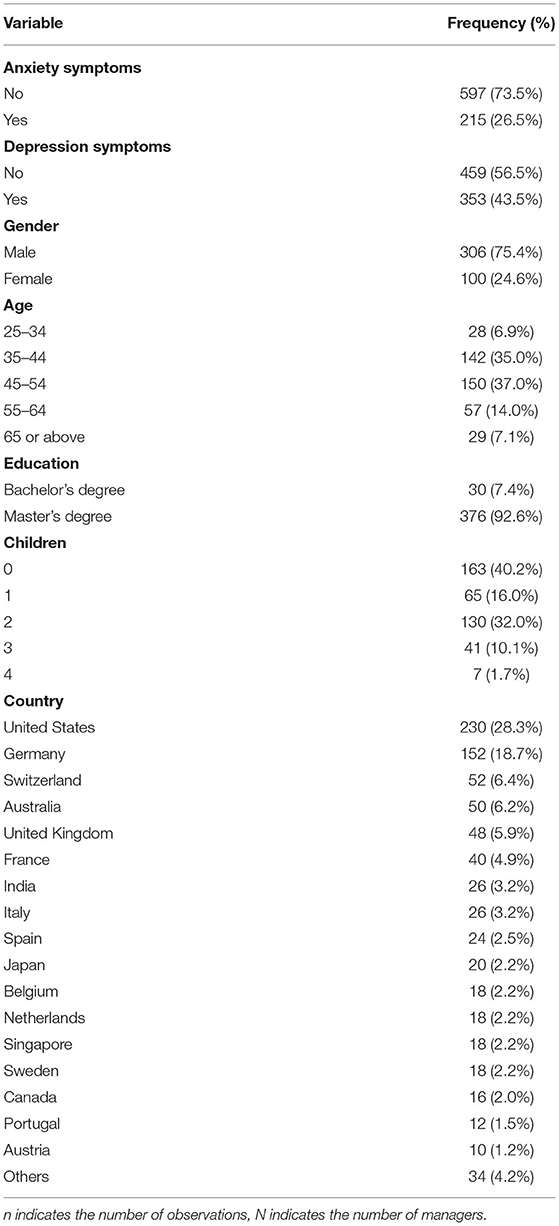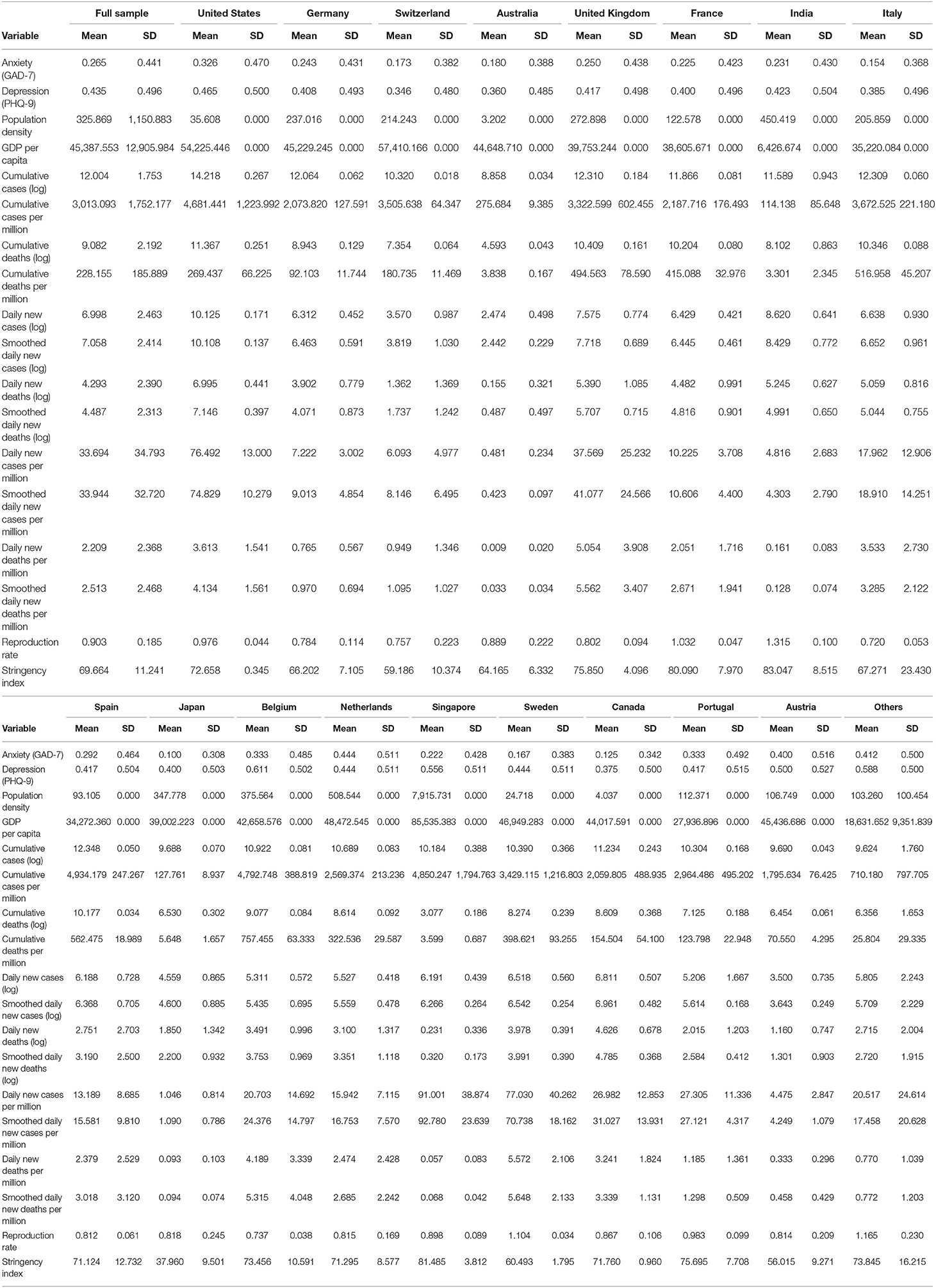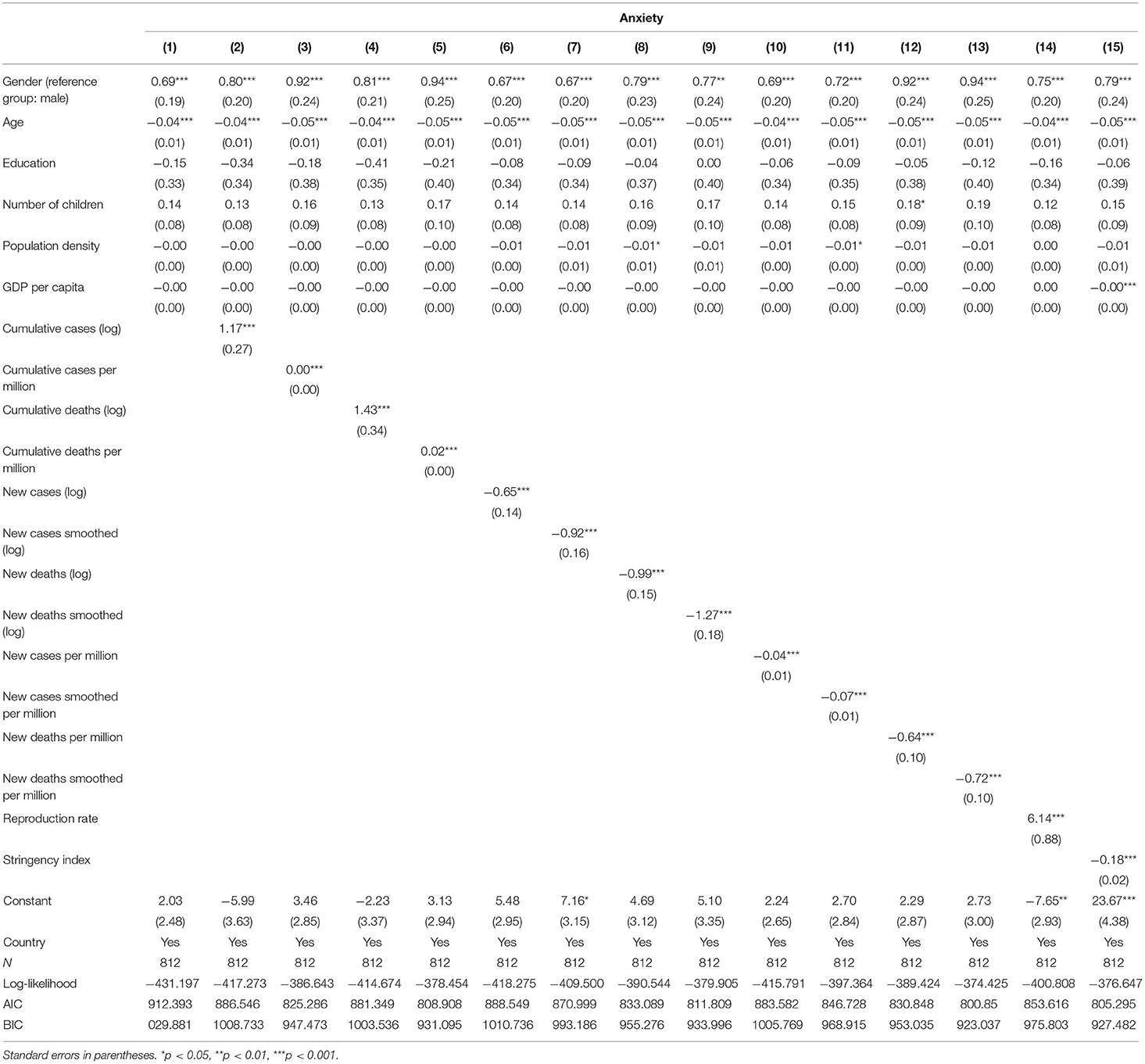- 1School of Economics and Management, Tsinghua University, Beijing, China
- 2Adelaide Business School, University of Adelaide, Adelaide, SA, Australia
- 3TU Dortmund University, Dortmund, Germany
- 4ESCP Business School, Paris, France
Background: There is limited research focusing on publicly available statistics on the Coronavirus disease 2019 (COVID-19) pandemic as predictors of mental health across countries. Managers are at risk of suffering from mental disorders during the pandemic because they face particular hardship.
Objective: We aim to predict mental disorder (anxiety and depression) symptoms of managers across countries using country-level COVID-19 statistics.
Methods: A two-wave online survey of 406 managers from 26 countries was performed in May and July 2020. We used logistic panel regression models for our main analyses and performed robustness checks using ordinary least squares regressions. In the sample, 26.5% of managers reached the cut-off levels for anxiety (General Anxiety Disorder-7; GAD-7) and 43.5% did so for depression (Patient Health Questionnaire-9; PHQ-9) symptoms.
Findings: We found that cumulative COVID-19 statistics (e.g., cumulative cases, cumulative cases per million, cumulative deaths, and cumulative deaths per million) predicted managers' anxiety and depression symptoms positively, whereas daily COVID-19 statistics (daily new cases, smoothed daily new cases, daily new deaths, smoothed daily new deaths, daily new cases per million, and smoothed daily new cases per million) predicted anxiety and depression symptoms negatively. In addition, the reproduction rate was a positive predictor, while stringency of governmental lockdown measures was a negative predictor. Individually, we found that the cumulative count of deaths is the most suitable single predictor of both anxiety and depression symptoms.
Conclusions: Cumulative COVID-19 statistics predicted managers' anxiety and depression symptoms positively, while non-cumulative daily COVID-19 statistics predicted anxiety and depression symptoms negatively. Cumulative count of deaths is the most suitable single predictor of both anxiety and depression symptoms. Reproduction rate was a positive predictor, while stringency of governmental lockdown measures was a negative predictor.
Introduction
Since the outbreak of COVID-19, many studies have examined the pandemic's influence on the general public's mental health in various countries (1–6). This stream of research predominantly studied predictors of mental health at the individual level, for example, demographic characteristics (6, 7).
Further, scholars have recently begun to focus on the mental health of specific groups, most prominently healthcare workers (4, 8–11), but also students (12), hospitality workers (13), footballers (14), etc. However, this research again studies non-country-level predictors and, critically, there is hardly any research focused on the specific group of managers (15). This is problematic because managers perform one of the most stressful and consequential jobs (16, 17). For one, during a pandemic, managers cannot manage as usual, and they may thus suffer particularly due to the decision-making and leadership responsibilities they must exercise during such a time of crisis (18). For another, managers' mental health may also have important second-order effects on their subordinates' lives and therefore their subordinates' mental health (15).
In addition, the majority of research on mental health during COVID-19 uses cross-sectional data (2, 6, 19), and several systematic reviews across countries (20–23) have revealed that there exists no cross-country research studying the link between the severity of the pandemic and managers' mental health. It is thus novel and likely practically useful to track changes in managers' mental health during a pandemic and identify the most suitable predictors for it (24).
This research aims to use country-level COVID-19 statistics to predict managers' anxiety and depression symptoms using two-wave online survey data. It is among the first to focus on the group of vulnerable managers (15), and the first to do so using longitudinal data. We first examine the predictive capabilities of different country-level pandemic severity statistics and then compare their effects on model fit to identify the most suitable predictor of mental health issues.
Methods
Sample and Procedure
We implemented a two-wave online survey to collect data from managers. The first-wave survey was conducted on May 2, 2020, and the second-wave survey was conducted on June 17, 2020. Respondents to our survey are former consultants of a global management consulting firm who moved into managerial roles after consulting. After dropping observations that had missing data in our country-level predictors, we had a total of 812 usable responses from 406 managers. Mean levels of anxiety and depression symptoms varied substantially across countries and over time in our sample. For example, the prevalence of anxiety and depression symptoms for the US was 13 and 14%, respectively, in the first-wave survey, and 52 and 79%, respectively, in the second-wave survey. In contrast, the prevalence of anxiety and depression for Japan was 0% in the first-wave survey; and the prevalence of anxiety and depression for Japan was 20 and 80% in the second-wave survey, respectively. Such increases were presumably driven by the constant pressures the pandemic exerted on managers over time. All managers participated voluntarily in the survey, which they could terminate at any time, and were not compensated. The study was approved by the responsible body at ESCP Business School (#2020-04-01 and #2020-06-01).
Measures for Individual-Level Variables
We measured anxiety using the generalized anxiety disorder (GAD-7) instrument, which consists of seven questions (α = 0.88), with a cutoff of 10 or greater indicating anxiety disorder symptoms (25). Depression was assessed using the Patient Health Questionnaire (PHQ-9), which consists of nine questions (α = 0.83), with a cutoff of 10 or greater indicating depression disorder symptoms (26, 27).
We also collected socio-demographic information (28), including gender (categorical), age in years (continuous), educational level (ordinal: completed less than secondary school/completed secondary school/attended some college but no degree/completed college degree/completed graduate degree), and number of children (continuous).
Measures for Country-Level Variables
We obtained cumulative counts of confirmed cases, cumulative counts of confirmed cases per million, cumulative counts of deaths, cumulative counts of deaths per million, daily counts of new confirmed cases, daily counts of new deaths, daily counts of new confirmed cases per million, and daily counts of new deaths per million for each country from the Coronavirus Resource Center (CRC) at Johns Hopkins University. All data was obtained for the exact day each manager responded to the survey.
We calculated smoothed values of daily counts of new confirmed cases, daily counts of new deaths, daily counts of new confirmed cases per million, and daily counts of new deaths per million by taking the mean of the daily values in the week prior to managers' responses. All absolute cumulative counts and daily new counts were log-transformed to account for the skewed distribution of the data. We obtained the reproduction rate of COVID-19 (i.e., the estimated number of new infections caused by a single infected individual) and a stringency index that measures the strictness of governments' lockdown policies for each country from Roser et al. (29). This stringency index comprises nine indicators, including school closures, workplace closures, and travel bans, and ranges from 0 (no policies) to 100 (very strict policies). To control for potential general country effects on mental health, we also considered population density and gross domestic product (GDP) per capita and obtained corresponding data from the World Bank.
Analysis
As our data on individuals' mental health is nested in the two-wave survey across 26 countries, we employed panel analysis (30). Specifically, we ran panel logistic regression analyses with dummy variables for countries using Stata 17 to predict managers' mental health issues at a significance level of 0.05.
We ran models separately for anxiety and depression. Specifically, for each dependent variable, we ran a model that included all individual-level predictors, and then 14 models that included all individual-level predictors and one country-level predictor each. We used AIC and BIC to identify the models with the best fit, and thus identify the most suitable country-level predictors for anxiety and depression, respectively.
Results
Descriptive Findings
Tables 1, 2 present descriptive statistics of the sampled managers and COVID-19 severity statistics across different countries. The mean scores of anxiety (GAD-7) and depression (PHQ-9) were 0.26 (SD = 0.44) and 0.43 (SD = 0.50), respectively. Overall, the proportion of our sampled participants with anxiety disorder symptoms is much lower (p = 0.000) in the first-wave survey (7.6%) compared to the second-wave survey (45.3%). Similarly, the prevalence of depression disorder symptoms is much lower (p = 0.000) in the first-wave survey (8.1%) compared to the second-wave survey (78.8%).
Of the 406 managers, 75.4% (306) were male. All held at least bachelor's degrees. Age ranged from 29 to 78 years. Most managers (40.2%) had no children.
For about half of the participants (44.6%), their countries' population density ranged between 1 and 100. GDP per capita in the countries of most managers (69.5%) ranged from 40,000 to 60,000 (constant 2011 US dollars). The reproduction rate of the COVID-19 epidemic ranged from 0.51 to 1.50, and the stringency index ranged from 28.7 to 96.3 across the 26 countries over the survey waves.
Predictors of Managers' Mental Health
As presented in Tables 3, 4, female managers were more likely than male managers to exhibit anxiety and depression symptoms. Age negatively predicted managers' anxiety and depression. The effects of education level and the number of children were not significant.
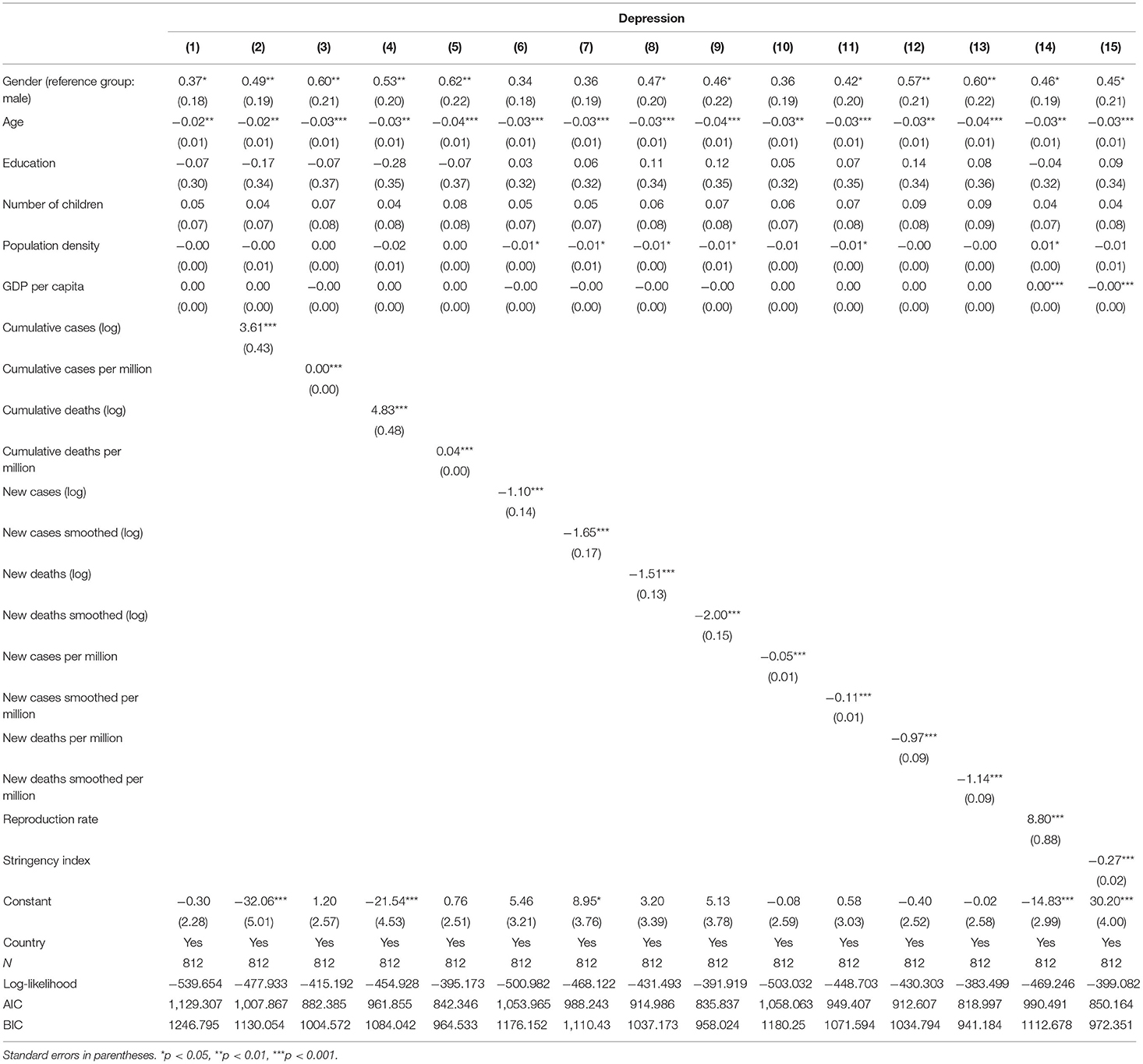
Table 4. Predictors of managers' depression symptoms in logistic panel regression (n = 812, N = 406).
More importantly, Model 2 in both Tables 3, 4 shows that cumulative confirmed cases positively predicted managers' anxiety (b = 5.42; 95% CI: 3.92–6.91; p < 0.001) and depression (b = 8.11; 95% CI: 6.81–9.41; p < 0.001) symptoms. Model 3 in Tables 3, 4 shows that cumulative confirmed cases per million positively predicted managers' anxiety (b = 0.00; 95% CI: 0.001–0.002; p < 0.001) and depression (b = 0.00; 95% CI: 0.002–0.002; p < 0.001) symptoms. Similarly, Model 4 in both Tables 3, 4 shows that cumulative deaths positively predicted anxiety (b = 6.42; 95% CI: 4.70–8.15; p < 0.001) and depression (b = 9.22; 95% CI: 7.88–10.55; p < 0.001) symptoms, and Model 5 in Tables 3, 4 shows that cumulative deaths per million also positively predicted symptoms of these disorders (b = 0.02; 95% CI: 0.02–0.03; p < 0.001 and b = 0.04; 95% CI: 0.03–0.04; p < 0.001).
Interestingly, Models 6 to 15 in Tables 3, 4 show that new confirmed cases negatively predicted managers' anxiety (b = −0.96; 95% CI: −1.30 to −0.61; p < 0.001) and depression (b = −1.52; 95% CI: −1.85 to −1.20; p < 0.001) symptoms. Smoothed new confirmed cases negatively predicted managers' anxiety (b = −1.47; 95% CI: −1.88 to −1.06; p < 0.001) and depression (b = −2.32; 95% CI: −2.71 to −1.92; p < 0.001) symptoms. In addition, daily new deaths negatively predicted the occurrence of anxiety (b = −1.18; 95% CI: −1.51 to −0.84; p < 0.001) and depression (b = −1.82; 95% CI: −2.11 to −1.52; p < 0.001) symptoms, respectively. Smoothed daily deaths negatively predicted anxiety (b = −1.55; 95% CI: −1.94 to −1.15; p < 0.001) and depression (b = −2.45; 95% CI: −2.80 to −2.09; p < 0.001) symptoms. We found corroborating evidence using population-adjusted predictors, i.e., new confirmed cases per million, smoothed new cases per million, new deaths per million, and smoothed new deaths per million.
The reproduction rate of COVID-19 positively predicted managers' anxiety (b = 6.20; 95% CI: 4.46–7.94; p < 0.001) and depression (b = 9.00; 95% CI: 7.23–10.77; p < 0.001) symptoms. Interestingly, the stringency index negatively predicted anxiety (b = −0.18; 95% CI: −0.23 to −0.13; p < 0.001) and depression (b = −0.29; 95% CI: −0.34 to −0.24; p < 0.001).
Finally, we compared the relative goodness fit of all models that include more predictors than the baseline Model 1 in Tables 3, 4. The cumulative count of deaths emerged as the most suitable predictor of managers' anxiety symptoms since both AIC and BIC for Model 4 were lower than for any alternative model. The cumulative count of deaths was also the most suitable predictor of managers' depression symptoms.
Furthermore, we ran supplemental ordinary least squares models predicting the absolute severity scores of GAD-7 and PHQ-9 (i.e., the sum of the scores across all items of each scale) as a robustness check. The results, which are fully consistent with the findings discussed above, are presented in Tables 5, 6.
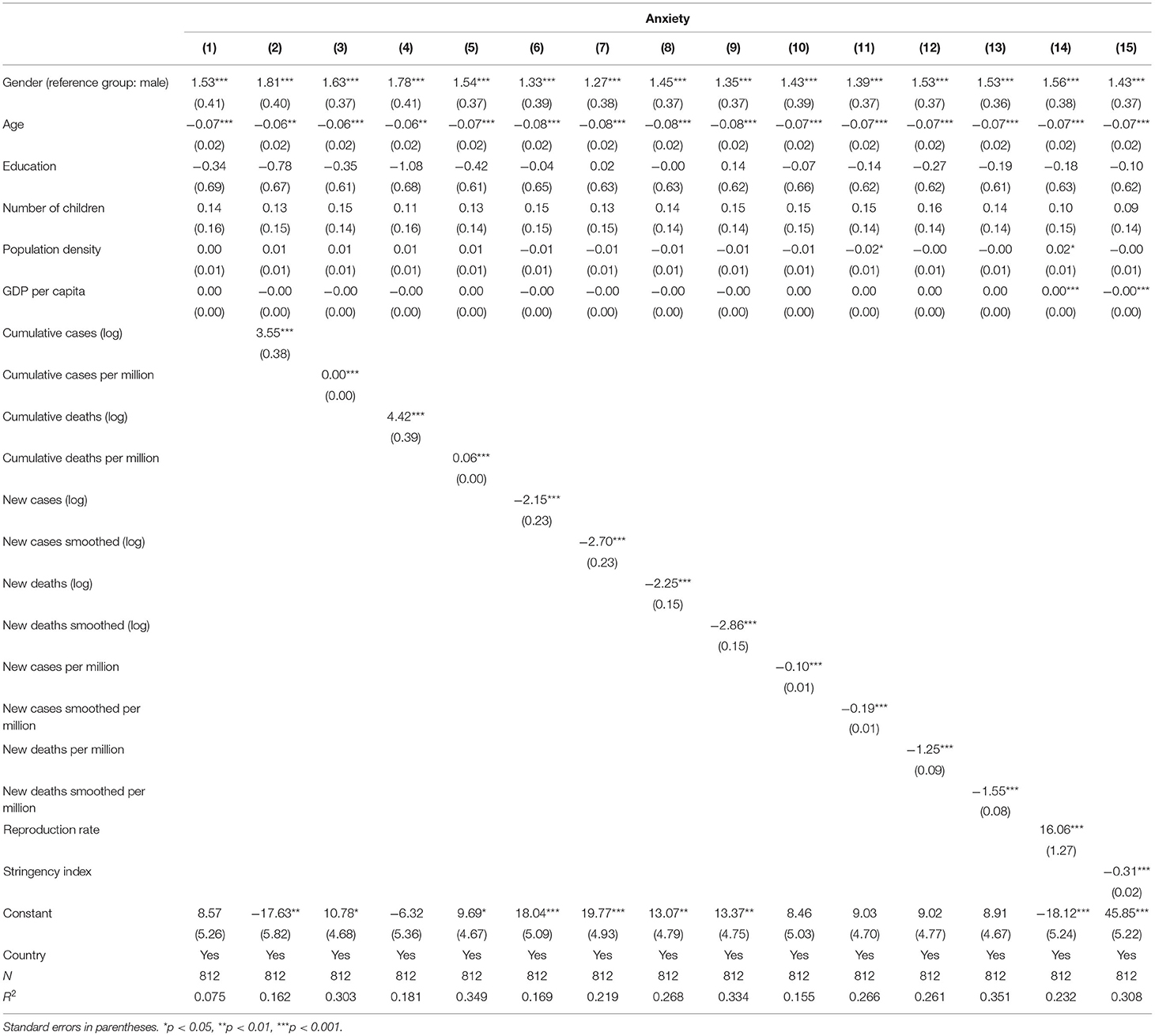
Table 5. Predictors of managers' anxiety symptoms in ordinary least squares regression (n = 812, N = 406).
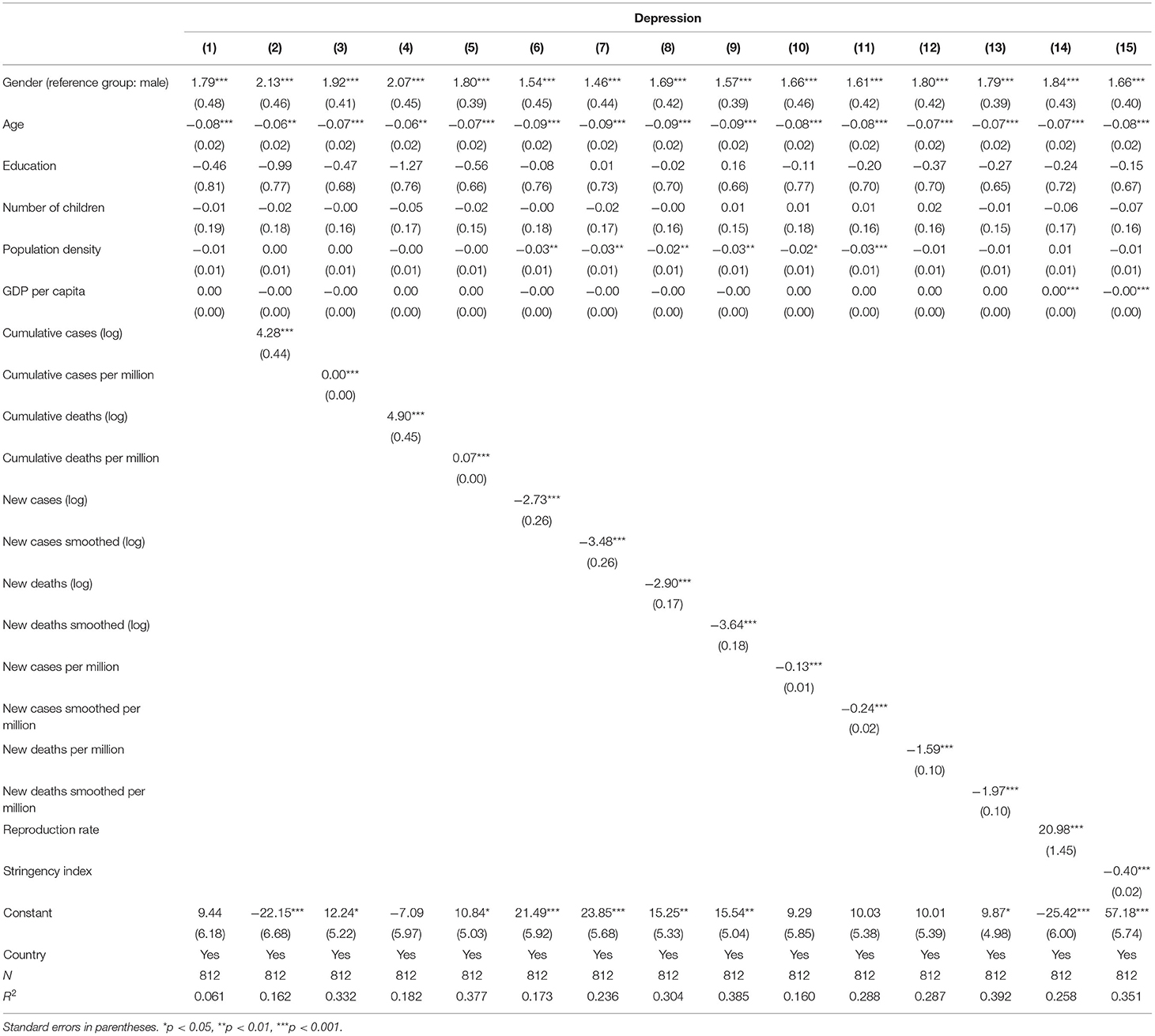
Table 6. Predictors of managers' depression symptoms in ordinary least squares regression (n = 812, N = 406).
As an additional robustness check, we re-ran all models while including measures for firm size as well as firms' changes in revenues and profits due to COVID-19. None of these additional predictors were significant, and none of the other results changed.
Discussion
This paper—which is the first to join public country-level COVID-19 statistics with a primary cohort cross-country survey to predict managers' mental disorders across countries—offers several insights that may help to understand manager's mental health across countries to better allocate mental health assistance resources.
First off, consistent with prior studies on other populations (12, 31, 32), gender and age were predictors of anxiety and depression symptoms in managers. For one, female managers were more likely to suffer from mental health problems than male managers. This is in line with the general literature on gender risk for mental health issues, which outlines various risk factors such as social expectations and biological givens that may explain a generally greater vulnerability of females (31–33). This literature also highlights the important role of stressful life events (34), which might of course have become more frequent during a pandemic. Our findings are further consistent with the emerging body of literature specific to the impact of COVID-19, which suggests that females may have a particular underlying vulnerability to negative emotions (24, 35) and are concerned more about economic burdens (35, 36) during the pandemic, compared to their male counterparts. All these factors may of course also promote mental health issues in female managers. For another, younger managers in our sample experienced greater mental distress, potentially because younger managers might have less experience with crisis situations and might thus have developed fewer coping techniques. Again, this finding is compatible with prior literature (12, 37). Our findings thus advise medical professionals to target younger and female managers with mental health service offerings. Notably, other predictors found in the literature, such as education (38) or the number of children (39), failed to predict mental health problems among managers across countries.
More importantly, this study examined country-level COVID-19 severity statistics as predictors of managers' mental health. As mentioned before, managers are a largely neglected vulnerable population that bears responsibility for guiding subordinates, potentially impacting the lives—and the mental health—of many (15). Our findings indicate that cumulative confirmed cases and deaths positively predict anxiety and depression symptoms for those managers during the COVID-19 pandemic, while daily new confirmed cases and deaths negatively predict these mental disorders. Surprisingly, thus, cumulative counts and daily new counts predict managers' mental health in opposing directions. The finding that cumulative counts are positively related with symptoms of mental health issues is fairly intuitive, since a growing cumulative count indicates that the overall magnitude of the COVID-19 crisis as an ongoing historic event increases. Managers might thus be adversely affected by the cumulation of pandemic-related stressors like lockdown measures over time (40). The finding regarding new daily counts is somewhat less intuitive and does not have any precedent in the literature, making it all the more intriguing. The likely most plausible explanation is that managers observing higher daily new counts anticipate satisfactory government intervention, possibly leading to a reduction in concerns over the situation (41). An alternative, but entirely speculative, explanation would be that managers, frequently working remotely during the pandemic, are reminded of their privileged positions by seeing that while daily new counts wreak havoc elsewhere, they themselves and their closer environments have thus far not been affected. This could lead to positive effects on mental health by way of downward comparison with less fortunate workers (42, 43).
Further, the virus reproduction rate positively predicts managers' anxiety and depression, which is intuitive because it directly reflects the speed of spread of COVID-19 and might thus affect the perception of whether the pandemic is controllable. Such control perceptions have repeatedly been linked to mental health consequences (44–46). Again, possibly surprisingly, however, the stringency index negatively predicted managers' mental disorders. In line with our speculation above, this might indicate that measures like school closures, workplace closures, and travel bans can assure people that the crisis is being dealt with and thus decrease managers' concerns about becoming infected or concerns about managing uncertainty in the workplace. This finding is novel compared to previous studies focusing on the general public (47, 48). A possible explanation is that we concentrate on a population with specific skills and views (49–51) that may thus interpret and cope with different indicators differently than the general population.
Finally, we identified cumulative deaths as the most suitable predictor for managers' mental health among the studied variables. Thus, healthcare service providers and human resource departments of multinational companies might particularly wish to use this simple and readily available statistic to prioritize help offerings to managers, at least in the earlier phases of a pandemic. Specifically, multinational companies might want to offer personal protective equipment, online consultation including cognitive behavioral therapy, or telemedicine services to their managers or provide them with other wellness resources to manage stress and improve coping, including workshops and self-help groups to reduce workplace-related stressors (12, 52). Such measures could provide managers with effective coping techniques like problem-focused coping (e.g., planning on what to change about the situation), self-supported emotional coping (e.g., learning to live with the situation), and social-support emotional coping (e.g., getting emotional support from others) (53).
Limitations and Future Research
There are several limitations to this study. First, we only collected two waves of data, restricting our ability to make causal claims. Although it is a cohort study, future scholars may track individuals' mental health over more waves with shorter intervals. Second, respondents were alumni of one of the most selective consulting firms in the world. It also is skewed heavily toward Western Europe and the United States. Hence, our sample is likely not representative of the overall global population of managers. Others might thus wish to replicate our findings in different manager populations to ensure generalizability. Third, our survey was voluntary, so the response rate was limited, and it is possible that managers with severe mental illness might not have responded in the first place. Additionally, we also did not collect data on respondents' prior psychiatric or psychological treatments, as well as chronic diseases that might affect their risk when contracting COVID-19. The generalizability of our findings might thus be restricted, and future researchers might wish to account for such information. Fourth, we collected only limited data on the organizations the managers were working in. This implies that future researchers might fruitfully replicate our research while, for example, accounting explicitly for organizations' specific responses to the pandemic including any organizational support managers might have received. Fifth, this study aims to explore epidemic statistics as predictors of mental health, and as the first study to do so, we did not extensively explore the possible mechanisms leading to mental health disorders. Our findings thus call for future research to further examine the nature of the relationship between epidemic statistics and mental health.
Conclusion
In conclusion, this study identified readily available country-level pandemic statistics as predictors of managers' mental health disorder symptoms. Specifically, cumulative COVID-19 statistics predict symptoms positively, while non-cumulative daily statistics predict the same symptoms negatively. The reproduction rate and the stringency index in each country also predicted mental health. These identified country-level predictors can be instrumental for managers' superiors, multinational firms' human resource departments, mental health organizations, and policymakers. In particular, the predictors are readily available from public sources and can help optimize resource allocation and mobilization across geographies during the COVID-19 pandemic.
Data Availability Statement
The original contributions presented in the study are included in the article/supplementary materials, further inquiries can be directed to the corresponding author/s.
Ethics Statement
The study was approved (#2020-0401 and #2020-06-01) at ESCP Business School. The patients/participants provided their written informed consent to participate in this study.
Author Contributions
LG-V collected the survey data. LL ran the analysis. All authors had access to the data and a role in writing the manuscript, designed the study, drafted the manuscript, and reviewed, edited, and approved the final article.
Funding
We acknowledge financial support by Deutsche Forschungs-gemeinschaft and TU Dortmund University within the funding program Open Access Costs.
Conflict of Interest
The authors declare that the research was conducted in the absence of any commercial or financial relationships that could be construed as a potential conflict of interest.
The reviewer Y-JW declared a shared affiliation with one of the authors, LG-V, to the handling editor at time of review.
Publisher's Note
All claims expressed in this article are solely those of the authors and do not necessarily represent those of their affiliated organizations, or those of the publisher, the editors and the reviewers. Any product that may be evaluated in this article, or claim that may be made by its manufacturer, is not guaranteed or endorsed by the publisher.
Acknowledgments
We would like to thank all survey participants.
References
1. Dai H, Zhang SX, Looi KH, Su R, Li J. Perception of health conditions and test availability as predictors of adults' mental health during the covid-19 pandemic: a survey study of adults in Malaysia. Int J Environ Res Public Health. (2020) 17:5498. doi: 10.3390/ijerph17155498
2. Jahanshahi AA, Dinani MM, Madavani AN, Li J, Zhang SX. The distress of Iranian adults during the Covid-19 pandemic – More distressed than the Chinese and with different predictors. Brain Behav Immun. (2020) 87:124–5. doi: 10.1016/j.bbi.2020.04.081
3. Gierc M, Riazi NA, Fagan MJ, Di Sebastiano KM, Kandola M, Priebe CS, et al. Strange days: adult physical activity and mental health in the first two months of the COVID-19 pandemic. Front Public Health. (2021) 9:325. doi: 10.3389/fpubh.2021.567552
4. Gramaglia C, Marangon D, Azzolina D, Guerriero C, Lorenzini L, Probo M, et al. The mental health impact of 2019-nCOVID on healthcare workers from north-eastern Piedmont, Italy. Focus on burnout Front Public Health. (2021) 9:483. doi: 10.3389/fpubh.2021.667379
5. Lateef T, Chen J, Tahir M, Lateef TA, Chen BZ, Li J, et al. Typhoon eye effect versus ripple effect: the role of family size on mental health during the COVID-19 pandemic in Pakistan. Global Health. (2021) 17:1–8. doi: 10.1186/s12992-021-00685-5
6. Zhang SX, Chen J, Jahanshahi AA, Alvarez-Risco A, Dai H, Li J, et al. Succumbing to the COVID-19 pandemic: healthcare workers not satisfied and intend to leave their jobs. Int J Ment Health Addiction. (2021). doi: 10.1007/s11469-020-00418-6
7. Guido CA, Amedeo I, Avenoso F, Bruni J, Zicari AM, Loffredo L, et al. Risk factors and mental health promotion strategies in children during COVID-19. Front Public Health. (2020) 8:573. doi: 10.3389/fpubh.2020.580720
8. Yáñez JA, Afshar Jahanshahi A, Alvarez-Risco A, Li J, Zhang SX. Anxiety, distress, and turnover intention of healthcare workers in Peru by their distance to the epicenter during the COVID-19 crisis. Am J Trop Med Hyg. (2020) 103:1614–20. doi: 10.4269/ajtmh.20-0800
9. Gong H, Zhang SX, Nawaser K, Jahanshahi AA, Xu X, Li J, et al. The mental health of healthcare staff working during the COVID-19 crisis: their working hours as a boundary condition. J Multidiscip Healthc. (2021) 14:1073. doi: 10.2147/JMDH.S297503
10. Zhang SX, Liu J, Jahanshahi AA, Nawaser K, Yousefi A, Li J, et al. At the height of the storm: Healthcare staff's health conditions and job satisfaction and their associated predictors during the epidemic peak of COVID-19. Brain Behav Immun. (2020) 87:144–6. doi: 10.1016/j.bbi.2020.05.010
11. Zhao Y, Guo J, Liu S, Aizezi M, Zeng Q, Sidike A, et al. Prevalence and related factors of depression, anxiety, acute stress, and insomnia symptoms among medical staffs experiencing the second wave of COVID-19 pandemic in Xinjiang, China. Front Public Health. (2021) 9:489. doi: 10.3389/fpubh.2021.671400
12. Han Z, Tang X, Li X, Shen Y, Li L, Wang J, et al. COVID-19-related stressors and mental health among Chinese college students: a moderated mediation model. Front Public Health. (2021) 9:803. doi: 10.3389/fpubh.2021.586062
13. Yan J, Kim S, Zhang SX, Foo MD, Alvarez-Risco A, Del-Aguila-Arcentales S, et al. Hospitality workers' COVID-19 risk perception and depression: a contingent model based on transactional theory of stress model. Int J Hosp Manage. (2021) 95:102935. doi: 10.1016/j.ijhm.2021.102935
14. Sun S, Zhang SX, Jahanshahi AA, Jahanshahi M. Drilling under the COVID−19 pandemic: a diary study of professional football players' mental health and workout performance. Stress Health. (2021) 38:3–18. doi: 10.1002/smi.3059
15. Graf-Vlachy L, Sun S, Zhang SX. Predictors of managers' mental health during the COVID-19 pandemic. Eur J Psychotraumatol. (2020) 11:1834195. doi: 10.1080/20008198.2020.1834195
16. Ivancevich JM, Matteson MT, Preston C. Occupational stress, type a behavior, and physical well being. Acad Manage J. (1982) 25:373–91. doi: 10.5465/255998
17. Egede LE, Ruggiero KJ, Frueh BC. Ensuring mental health access for vulnerable populations in COVID era. J Psychiatr Res. (2020) 129:147–8. doi: 10.1016/j.jpsychires.2020.07.011
18. Palmer S. Managers More Likely to Be Diagnosed With a Mental Health Condition Than Other Employees. People Management (2019). Available online at: https://www.peoplemanagement.co.uk/news/articles/managers-more-likely-diagnosed-mental-health-condition-other-employees (accessed November 7, 2020).
19. Ke Y-T, Hung C-H. Factors that affect the health status of health care providers—a cross-sectional design. J Nurs Manag. (2020) 28:1199–206. doi: 10.1111/jonm.13057
20. Chen J, Farah N, Dong RK, Chen RZ, Xu W, Yin J, et al. Mental health during the COVID-19 crisis in africa: a systematic review and meta-analysis. Int J Environ Res Public Health. (2021) 18:10604. doi: 10.3390/ijerph182010604
21. Pappa S, Chen J, Barnett J, Chang A, Dong RK, Xu W, et al. A systematic review and meta-analysis of the mental health symptoms during the Covid-19 pandemic in Southeast Asia. Psychiatry Clin Neurosci. (2021) 76:41–50. doi: 10.1101/2021.06.03.21258001
22. Zhang SX, Chen J. Scientific evidence on mental health in key regions under the COVID-19 pandemic–meta-analytical evidence from Africa, Asia, China, Eastern Europe, Latin America, South Asia, Southeast Asia, and Spain. Eur J Psychotraumatol. (2021) 12:2001192. doi: 10.1080/20008198.2021.2001192
23. Zhang SXO, Miller SO, Xu W, Yin A, Chen B, Delios A, et al. Meta-analytic evidence of depression and anxiety in Eastern Europe during the COVID-19 pandemic. Eur J Psychotraumatol. (2021). doi: 10.1101/2021.06.21.21259227
24. Daly M, Sutin AR, Robinson E. Longitudinal changes in mental health and the COVID-19 pandemic: evidence from the UK household longitudinal study. Psychol Med. (2020) 1–10. doi: 10.1017/S0033291720004432
25. Spitzer RL, Kroenke K, Williams JBW, Löwe B. A brief measure for assessing generalized anxiety disorder: the GAD-7. Arch Intern Med. (2006) 166:1092. doi: 10.1001/archinte.166.10.1092
26. Kroenke K, Spitzer RL, Williams JBW. The PHQ-9. J Gen Intern Med. (2001) 16:606–13. doi: 10.1046/j.1525-1497.2001.016009606.x
27. Kroenke K, Spitzer RL, Williams JBW, Löwe B. The patient health questionnaire somatic, anxiety, and depressive symptom scales: a systematic review. Gen Hosp Psychiatry. (2010) 32:345–59. doi: 10.1016/j.genhosppsych.2010.03.006
28. Chen J, Zhang SX, Wang Y, Jahanshahi AA, Dinani MM, Madavani AN, et al. The relationship between age and mental health among adults in Iran during the COVID-19 pandemic. Int J Ment Health Addict. (2021) 22:1–16. doi: 10.1007/s11469-021-00571-6
29. Roser M, Ritchie H, Ortiz-Ospina E, Hasell J. Coronavirus Pandemic (COVID-19). Our World in Data (2020). Available online at: https://ourworldindata.org/coronavirus. Available online at: https://ourworldindata.org/coronavirus (accessed December 19, 2020).
30. Hsiao C. Analysis of Panel Data. 3rd ed. Cambridge: Cambridge University Press (2014). Available online at: https://www.cambridge.org/core/books/analysis-of-panel-data/A774C63FF969DA1944A3F91501702C65 (accessed November 7, 2020).
31. Kinrys G, Wygant LE. Anxiety disorders in women: does gender matter to treatment? Braz J Psychiatry. (2005) 27:s43–50. doi: 10.1590/S1516-44462005000600003
32. Remes O, Brayne C, Linde R, van der Lafortune L. A systematic review of reviews on the prevalence of anxiety disorders in adult populations. Brain Behav. (2016) 6:e00497. doi: 10.1002/brb3.497
33. Seeman MV. Mental illness in women. In: Goldman MB, Hatch MC, editors. Women and Health. San Diego, CA: Academic Press (2000). p. 989–96.
34. Kendler KS, Kessler RC, Neale MC, Heath AC, Eaves LJ. The prediction of major depression in women: toward an integrated etiologic model. Am J Psychiatry. (1993) 150:1139. doi: 10.1176/ajp.150.8.1139
35. Xiong J, Lipsitz O, Nasri F, Lui LMW, Gill H, Phan L, et al. Impact of COVID-19 pandemic on mental health in the general population: a systematic review. J Affect Disord. (2020) 277:55–64. doi: 10.1016/j.jad.2020.08.001
36. Almeida M, Shrestha AD, Stojanac D, Miller LJ. The impact of the COVID-19 pandemic on women's mental health. Arch Womens Ment Health. (2020) 23:741–8. doi: 10.1007/s00737-020-01092-2
37. Shechory Bitton M, Laufer A. Mental health and coping in the shadow of the COVID-19 pandemic: the Israeli case. Front Public Health. (2021) 8:1016. doi: 10.3389/fpubh.2020.568016
38. Zhang SX, Wang Y, Rauch A, Wei F. Unprecedented disruption of lives and work: health, distress and life satisfaction of working adults in China one month into the COVID-19 outbreak. Psychiatry Res. (2020) 288:112958. doi: 10.1016/j.psychres.2020.112958
39. Ahmad A, Rahman I, Agarwal M. Early psychosocial predictors of mental health among Indians during coronavirus disease 2019 outbreak. J Health Sci. (2020) 10:147–56. doi: 10.17532/jhsci.2020.950
40. Pierce M, Hope H, Ford T, Hatch S, Hotopf M, John A, et al. Mental health before and during the COVID-19 pandemic: a longitudinal probability sample survey of the UK population. Lancet Psychiatry. (2020) 7:883–92. doi: 10.1016/S2215-0366(20)30308-4
41. Mækelæ MJ, Reggev N, Dutra N, Tamayo RM, Silva-Sobrinho RA, Klevjer K, et al. Perceived efficacy of COVID-19 restrictions, reactions and their impact on mental health during the early phase of the outbreak in six countries. R Soc Open Sci. (2020) 7:200644. doi: 10.1098/rsos.200644
42. Wills TA. Downward comparison as a coping mechanism. In: Snyder CR, Ford CE, editors. Coping With Negative Life Events: Clinical and Social Psychological Perspectives the Plenum Series on Stress and Coping. Boston, MA: Springer US (1987). p. 243–68.
43. VanderZee KI, Buunk BP, Sanderman R. Social comparison as a mediator between health problems and subjective health evaluations. Br J Soc Psychol. (1995) 34:53–65. doi: 10.1111/j.2044-8309.1995.tb01048.x
44. Southwick FS, Southwick SM. The loss of a sense of control as a major contributor to physician burnout: a neuropsychiatric pathway to prevention and recovery. JAMA Psychiatry. (2018) 75:665–6. doi: 10.1001/jamapsychiatry.2018.0566
45. Hovenkamp-Hermelink JHM, Jeronimus BF, van der Veen DC, Spinhoven P, Penninx BWJH, Schoevers RA, et al. Differential associations of locus of control with anxiety, depression and life-events: a five-wave, nine-year study to test stability and change. J Affect Disord. (2019) 253:26–34. doi: 10.1016/j.jad.2019.04.005
46. Wierenga KL, Moore SE, Pressler SJ, Hacker ED, Perkins SM. Associations between COVID-19 perceptions, anxiety, and depressive symptoms among adults living in the United States. Nurs Outlook. (2021) 69:755–66. doi: 10.1016/j.outlook.2021.03.020
47. O'Hara L, Rahim HFA, Shi Z. Gender and trust in government modify the association between mental health and stringency of social distancing related public health measures to reduce COVID-19: a global online survey. medRxiv. (2020). doi: 10.1101/2020.07.16.20155200
48. Ssentongo P, Fronterre C, Geronimo A, Greybush SJ, Mbabazi PK, Muvawala J, et al. Tracking and predicting the African COVID-19 pandemic. medRxiv. (2020). doi: 10.1101/2020.11.13.20231241
49. Carter JR, Irons MD. Are economists different, and if so, why? J Econ Perspect. (1991) 5:171–7. doi: 10.1257/jep.5.2.171
50. Johnson JEV, Powell PL. Decision making, risk and gender: are managers different? Br J Manag. (1994) 5:123–38. doi: 10.1111/j.1467-8551.1994.tb00073.x
51. Kaplan SN, Sorensen M. Are CEOs different? Characteristics of top managers. Natl Bureau Econ Res. (2017). doi: 10.3386/w23832
52. Pfefferbaum B, North CS. Mental health and the COVID-19 pandemic. N Engl J Med. (2020) 383:510–2. doi: 10.1056/NEJMp2008017
Keywords: managers, mental disorders, cumulative deaths, COVID-19, cross-country
Citation: Li L, Zhang SX and Graf-Vlachy L (2022) Predicting Managers' Mental Health Across Countries: Using Country-Level COVID-19 Statistics. Front. Public Health 10:791977. doi: 10.3389/fpubh.2022.791977
Received: 09 October 2021; Accepted: 03 February 2022;
Published: 19 May 2022.
Edited by:
Christos Theleritis, National and Kapodistrian University of Athens, GreeceReviewed by:
Iwona Rotter, Pomeranian Medical University, PolandYi-Jhen Wu, Technical University Dortmund, Germany
Copyright © 2022 Li, Zhang and Graf-Vlachy. This is an open-access article distributed under the terms of the Creative Commons Attribution License (CC BY). The use, distribution or reproduction in other forums is permitted, provided the original author(s) and the copyright owner(s) are credited and that the original publication in this journal is cited, in accordance with accepted academic practice. No use, distribution or reproduction is permitted which does not comply with these terms.
*Correspondence: Lorenz Graf-Vlachy, bG9yZW56LmdyYWYtdmxhY2h5QHR1LWRvcnRtdW5kLmRl
 Lun Li
Lun Li Stephen X. Zhang
Stephen X. Zhang Lorenz Graf-Vlachy
Lorenz Graf-Vlachy